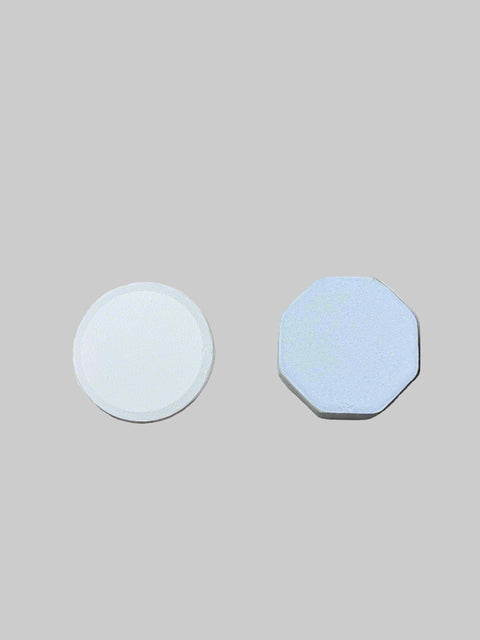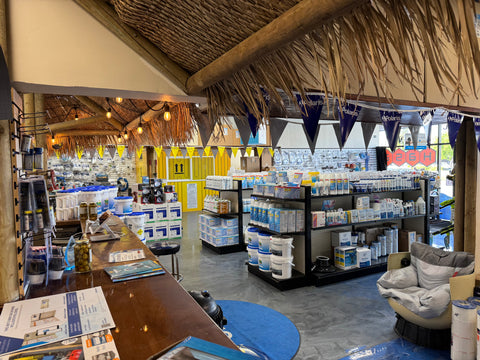Chlorine Tablets for Pools – Complete Buyer’s Guide to Trichlor vs. Cal-Hypo
Introduction: Why Chlorine Tablets Remain a Pool Essential
Crystal-clear, safe swimming water doesn’t happen by accident — it requires consistent and balanced sanitation. For many years, chlorine tablets for pools have been the top choice. They are reliable, easy to use, and offer steady protection against bacteria, algae, and cloudy water.
Chlorine tablets dissolve slowly. This is different from liquid chlorine, which goes away quickly. Granular pool shock is best for one-time treatments. This steady release ensures that pools maintain safe, stable chlorine levels without daily dosing.
But not all chlorine tablets are the same. The two most common types, trichlor and calcium hypochlorite (cal-hypo), behave very differently. Choosing the wrong type, or using them incorrectly, can cause corrosion, scaling, chlorine lock, or even safety hazards.
This expanded guide covers everything you need to know to use tablets the smart way.
👉 Ready to buy? Shop our Chlorine Tablets Collection today.
Quick Links
What Are Chlorine Tablets and How Do They Work?
Chlorine tablets dissolve slowly in water, releasing Free Available Chlorine (FAC). FAC is the “working chlorine” that sanitizes water by killing bacteria, destroying algae, and oxidizing organic contaminants.
The two main tablet types are:
-
Trichlor (Trichloro-s-Triazinetrione) – Stabilized, acidic, ~90–99% chlorine.
-
Cal-Hypo (Calcium Hypochlorite) – Non-stabilized, alkaline, up to 99% chlorine.
👉 Explore more sanitizers in our Pool Chemicals Collection.
Trichlor Tablets: The Standard Choice for Summer
Advantages
-
High chlorine concentration (90–99%).
-
Stabilizer (CYA) protects chlorine from sunlight.
-
Works with floaters and automatic feeders.
-
Long-lasting, steady release.
Drawbacks
-
Very acidic (pH ~3), corrosive if placed in the skimmer.
-
Constantly raises CYA → risk of chlorine lock.
-
Works best in summer, not ideal year-round.
👉 For proper use, shop Floating Chlorinators.
Cal-Hypo Tablets: The Powerful Alternative
Advantages
-
Up to 99% available chlorine.
-
No stabilizer, great for high-CYA pools.
-
Strong oxidation for algae control.
-
Good for shocking and heavy use.
Drawbacks
-
Adds calcium → scaling risk in hard water.
-
Dissolves faster in warm water.
-
Requires a separate, dedicated feeder.
👉 For other strong oxidizers, see our Pool Shock Collection.
Chlorine Strength: 90% vs. 99% Tablets
-
90% Tablets (Trichlor) – Effective, but include more stabilizer and inert fillers.
-
99% Tablets (Trichlor or Cal-Hypo) – Higher quality, cleaner, and more concentrated.
👉 Stock up with Bulk Chlorine Tablets for efficiency and savings.
⚠️ Safety Warning: Never Mix Trichlor and Cal-Hypo
Mixing these two can cause:
-
Fire or explosions
-
Toxic gas release
-
Severe equipment damage
👉 Always keep them in separate feeders and storage. For safe dosing, see Automatic Chlorinators.
The Risks of Overusing Chlorine Tablets
-
Equipment damage – Acidic or alkaline water eats away at seals and heaters.
-
Overchlorination – Eye and skin irritation.
-
Imbalances – Too much CYA (trichlor) or calcium (cal-hypo).
-
Wasted money – More tabs don’t equal cleaner water.
👉 Keep balanced with Pool Test Kits & Strips.
Seasonal Strategy: When to Use Chlorine Tablets
-
Summer – Tablets work best under high chlorine demand.
-
Spring/Fall – Use sparingly, supplement with liquid chlorine.
-
Winter – Switch to liquid chlorine only.
👉 Find seasonal sanitizers in our Liquid Chlorine Collection.
How to Use Chlorine Tablets Safely
-
Use floaters or dedicated feeders only.
-
Never put tablets in the skimmer.
-
Store in cool, ventilated spaces.
-
Keep trichlor and cal-hypo separate.
-
Wear gloves and safety gear.
👉 Keep your chemistry in check with a Professional Pool Test Kit.
Alternatives to Chlorine Tablets
-
Liquid Chlorine (Sodium Hypochlorite) – Fast, no stabilizer.
-
Granular Cal-Hypo – Great for shocks.
-
Saltwater Chlorinators – Low-maintenance, steady chlorine production.
👉 Explore Saltwater Pool Systems for long-term convenience.
FAQs
Q: Can I use tablets year-round?
A: Best in summer; switch to liquid chlorine in cooler months.
Q: How many tablets per week?
A: 2–4 per 10,000 gallons, adjusted to pool conditions.
Q: Are 99% tablets worth it?
A: Yes — fewer fillers, more efficiency.
Q: Can I put tablets in the skimmer?
A: No — corrosive water will damage equipment.
Q: Why not mix trichlor and cal-hypo?
A: Explosive and unsafe chemical reaction.
Q: Do trichlor tablets raise stabilizer levels?
A: Yes. Cal-hypo tablets don’t, but add calcium.
Conclusion: Smarter Tablet Use for a Healthier Pool
Chlorine tablets are still one of the easiest ways to sanitize pools — but only when used properly.
-
Trichlor tablets – Stabilized, ~90–99% chlorine. Best in summer, but raise stabilizer levels.
-
Cal-Hypo tablets – Up to 99% chlorine, no stabilizer. Best for high-CYA pools but add calcium.
👉 Key rules:
-
Never mix trichlor and cal-hypo.
-
Never place tablets in the skimmer.
-
Use tablets seasonally, not year-round.
Mixing tablets with liquid chlorine, shocks, or salt systems will give you clear water. This also protects your pool equipment and saves you money.
👉 Shop our Chlorine Tablets today and keep your pool sparkling all summer long.




